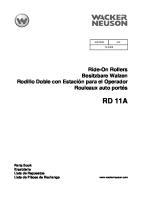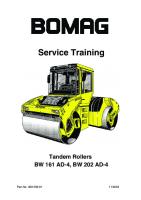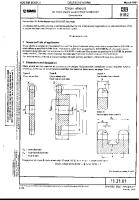Roller Compaction [PDF]
DRY GRANULATION TECHNIQUES – ROLLER COMPACTION Contents Brief Granulation Introduction ................................
52 0 575KB
Papiere empfehlen
![Roller Compaction [PDF]](https://vdoc.tips/img/200x200/roller-compaction.jpg)
- Author / Uploaded
- Addi Rashe'd
Datei wird geladen, bitte warten...
Zitiervorschau
DRY GRANULATION TECHNIQUES – ROLLER COMPACTION
Contents Brief Granulation Introduction ........................................................................................................... 2 Importance of Granulation ................................................................................................................ 2 Factors affecting Roll Compaction process ................................................................................... 4 Requirements for Roller Compaction............................................................................................. 4 Functional Principle/Theory of Roller Compaction ............................................................................. 5 Basic process of Roller Compaction .............................................................................................. 5 Effect of roller surface on granule shape ....................................................................................... 6 The Key Bonding Mechanism of compacts .................................................................................... 6 Design of Roller Compactors ............................................................................................................ 7 Feed System ................................................................................................................................. 7 Roller unit ...................................................................................................................................... 8 Factors influencing bypass in roller unit ......................................................................................... 9 Granulator/Mill system................................................................................................................. 10 Significance of excipients in formulation design process ................................................................. 11 Advantages of Roller Compaction ................................................................................................... 13 References ..................................................................................................................................... 14
DRY GRANULATION TECHNIQUES – ROLLER COMPACTION
Brief Granulation Introduction Granulation refers to the act or process in which primary powder particles are made to adhere to form larger, multi particle entities called granules. It is the process of collecting particles together by creating bonds between them. Bonds are formed by compression or by using a binding agent. The granulation process combines one or more powders and forms a granule that will allow the tableting process to be predictable and will produce quality tablets within the required tablet-press speed range. Pharmaceutical oral solid dosage forms have been used widely for decades mainly due to their convenience of administration and their suitability for delivery of drugs for systemic effects. The most commonly used pharmaceutical solid dosage forms today include granules, pellets, tablets and capsules. Granulation is done by two ways:
Wet granulation Dry granulation
In this section, we will be focusing on the Dry granulation technique-Roller compaction, suitable for processing drugs, which are sensitive to moisture and temperature; given that the underlying drug product has inherent compression properties
Importance of Granulation The granule properties play a pivotal role in the final performance of a tablet; for example, granule size can affect the flow ability and hence, the average tablet weight and weight variation. Having consistent flow of a granulation provides the needed avenues to control tablet weights. Consistent tablet weight will result in repeatable tablet hardness. Improved and homogeneous granulation will improve mixture, its flow ability, compressibility and therefore, improved disintegration with acceptable dissolution rate. The chief reasons to granulate powder for the manufacturing of pharmaceutical dosage forms include:
Prevention of segregation of the constituents of the powder mix Improve the flow properties of the mix and improve the compaction characteristics of the mix. The granulation of toxic materials will reduce the hazard associated with the generation of toxic dust that may arise when handling powders To remove wet granulation induced degradants and to improve product stability To reduce product bulk, thereby minimizing storage and enhancing transport.
DRY GRANULATION TECHNIQUES – ROLLER COMPACTION
DRY GRANULATION TECHNIQUES – ROLLER COMPACTION
Roller Compaction In a roller compactor material particles are consolidated and densified by passing the material between two high-pressure rollers. The densified material from a roller compactor is then reduced to a uniform granule size by milling. Roller compaction dry granulation process is capable of handling a large amount of material in a short period. As a special subtype briquetting utilizes special designed compaction rolls which divides the compacted powder in pieces (briquettes). For dry granulation the compaction force in extend and uniformity of distribution is essential about uniformity of granules porosity to ensure uniform hardness and disintegration of the final product.
Factors affecting Roll Compaction process Because of its advantages, roll compaction is being increasingly used as a granulation technique, but it is not a simple process and may involve many variables for example roll pressure roll speed screw speed roller gap These parameters need to be optimized depending on the materials and the type of equipment used in order to obtain products of desirable quality. Poor control of any of these variables may result in porous dense sheets that will eventually result in irregular shaped granules.
Dry granulation may be used if the materials have sufficient inherent binding or cohesive properties to form granules
Requirements for Roller Compaction For successful granulation, the following conditions should be satisfied: Adequate supply of the powder to the nip region and entire conveying of powder entering from nip region into the narrowest part of the roll gap Uniform distribution of the compaction pressure over the whole roll-gripped mass Adequate, effective and uniform de-aeration of powder mass via vacuum before it reaches the nip region. Material to be processed should be compressible, should have consistent increase in density with force, suitable for milling operation and recompression, if required
DRY GRANULATION TECHNIQUES – ROLLER COMPACTION
Functional Principle/Theory of Roller Compaction
R
oll compaction is an agglomeration process in which powder is fed by either gravity or by means of a screw feeder through two equal diameters countercurrently rotating rollers. The friction between the material being processed and roller surface brings the powder towards the narrow space between the roll (nip region), where the powder is subjected to high stresses leading to the formation of compact. The dense ribbons leave the compaction rang through eject region If in-line granulator/mill system is available with the system, it will mill ribbons or briquettes into granules otherwise densified sheets (ribbons) can be dry-sized by an oscillating mill, cone mill or impact mill. The produced granules are usually an intermediate product form and subsequently will be fed to a compression machine to ensure more efficient feeding or filled into capsules
Basic process of Roller Compaction During roll compaction, the powder blends are fed into the gap between two rollers (compaction zone) which is divided into three regions namely slip or entry region, nip region and release region. The boundaries between the regions are defined by their angular positions. In the slip or entry region powder starts to move but at a speed slower than the roll speed, thus indicating that slips occur therefore termed “slips”. Entry angle defines the start of this region and corresponds to the angular position at which there is a finite roll pressure. Particle rearrangement and de-aeration may occur, but the pressure exerted on the powder is relatively small. The nip region starts at a roll angle (nip angle), when the wall velocity of the powder becomes equal to that of the rolls. Nip angle: The angle between the heap of powder and axis of rotation. The smaller the angle, the greater compaction force is exerted on the powder and vice versa. The powder is ‘nipped’ and densification occurs due to the decrease in the gap. This results in a significant increase in the roll pressure. The release region starts when the roll gap starts to increase again and its size depends on the stored elastic strains in the compact, release rate of compact and the roll speed.
DRY GRANULATION TECHNIQUES – ROLLER COMPACTION
Effect of roller surface on granule shape If the rolls are smooth or fluted or knurled, the material is compacted into dense ribbons (flakes, sheets, strips), whereas pocket rolls will form briquettes. The production of either briquettes or granules depends on the application. Usually, briquettes are produced when large, dense agglomerates are required. Granules are produced when smaller, uniform particles are required for further processing
The Key Bonding Mechanism of compacts The key bonding mechanism involved in compact formation includes strongest solid bridges between particles, weaker attraction intermolecular/long distance forces (van der Waals forces, electrostatic forces, hydrogen bonding) or mechanical interlocking which denotes hooking and twisting of irregularly shaped particles.
DRY GRANULATION TECHNIQUES – ROLLER COMPACTION
Design of Roller Compactors A roll compactor unit usually consists of the following: feed system which conveys powder to rolls roller compaction system which densifies/compacts loose powder into ribbons or briquettes in-line granulator/mill system which mill ribbons or briquettes into granules
Feed System Feed systems play a vital role in successful formation of compact and control of process parameters. Non-uniform filling/conveying may possibly lead to: poor compact quality, generation of excess fines more un-compacted materials. Two type of feed system are used for powder conveying powder to the compaction unit. 1. gravity feeding by use of hopper or force feeding using feed hopper and screw feeder. When the powder is dense and free flowing, gravity feed system can be used reported the use of gravity feeding by a simple hopper, with a simple flap hopper and gravity feeder with flap distribution box. 2. Screw feeder is used for fine and fluffy powders having poor flow ability and inconsistent bulk density. A screw feeder is used to provide pre-compression force to the powder as it enters the roller press. This force increases the friction between the powder and the roll surfaces to improve compaction. Two basic types of screw feeders can apply this force: i) single screw feeder ii) double screw feeder For larger roll widths double screw feeder system is convenient to feed powder uniformly across the entire roll. The horizontal screw fixed in the powder reservoir conveys powder from the feed hopper to the vertical screw (temping screw) and each vertical screw partially de-aerates, pre-compresses and force-feeds the powder down into the nip region.
DRY GRANULATION TECHNIQUES – ROLLER COMPACTION
Roller unit The roller unit includes two equal diameter counter rotating rollers. Two different types of roll compactors are commercially available:
fixed gap systems
The gap width between rollers is pre-defined and fixed when roll compactor with fixed rollers is used. In these systems material flow is controlled by screw feeder speed only to get a constant densification of the material between two rollers In fixed gap systems ribbons of same geometrical dimensions are produced but nonhomogeneous powder feed between the rollers is observed which leads to a change in porosity of the produced ribbons and variation in compaction pressure is also observed. This may lead to non-desirable changes in product quality. variable gap systems. In this system even compaction force is achieved by control of both the gap width and the screw feeder speed. Additionally, movable gap systems have less bypass propensity. By changing roll gap, density profile of the compacts can also be changed with changed robustness of the granules which subsequently effect mechanical properties of the tablets In variable gap systems, at a given compaction pressure, actual gap size mainly results from screw feeder speed, roll speed and density of the fed powder. Thus, transportation of non-free-flowing powder and resulting changes in powder density may only lead to gap size variations which causes non-uniform ribbon thickness, with negligible effects on porosity due to maintenance of constant compaction pressure.
DRY GRANULATION TECHNIQUES – ROLLER COMPACTION
Factors influencing bypass in roller unit Bypass is un-granulated material that circumvents the rolls completely, or passes between the rolls without being adequately compacted and is major cause of segregation of blend and consequently content uniformity. Three major factors which influence bypass includes: I.
roller surface roughness/design The roll surface is important in maintaining a back pressure on the powder flow so that the powder does not pass through the nip region faster than the rolls are turning. Bypass can be minimized by use of rolls having greater roll roughness or use of textured surface (knurled). Three different types of continuous ribbon rolls are available with different surface designs intended to maintain this back pressure. These include knurled roll, serrated roll and smooth roll.
II.
roll orientation Three types of roll orientation are commercially available: A. Horizontal orientation B. In-cline orientation C. Vertical orientation
The roll orientation plays significant role in generation and minimization of bypass. In horizontal roll orientation, the loss of material due to bypass is high as compared to other designs. In horizontal orientation, material may remain in nip region for certain, uncontrolled period, which may negatively affect ribbon uniformity. In vertical orientation, loss of un-compacted material is minimal due to independence of feed to gravitational forces.
DRY GRANULATION TECHNIQUES – ROLLER COMPACTION
Inclined roll orientation decreases bypass from 15-20% to 7%. Incorporation of side seals (sealing strips) in compactor design reduces material bypass but this does not have significant effect to reduce material passing through the rolls without being sufficiently compacted.
III.
vacuum de-aeration This is an optional feature and usually applied during feeding to remove excess air from a fine powder with low bulk density. The application of vacuum eliminates entrained air that can cause the powder to resist the pre-compression force applied by the screw feeder. This technique is particularly useful for process with no screening or recycling steps or for greatly increasing the compaction efficiency of roll compactor. Vacuum de-aeration requires a vacuum pump system, which is linked to the feeder and removes the powder’s entrained air through a filter before the powder enters the roller press
Granulator/Mill system Granulation/milling of ribbons or briquettes obtained from compaction can be done using an in-line oscillating rotor-granulator or separate granulation in an oscillating mill, a cone mill or impact mill. In most of the equipment, in-line granulator can be used in two ways: use of coarse and fine (two stage) granulator to get desired sized granules. use of fine (single stage) granulator in which fines and oversize are separated using sifter and recycled via vacuum conveying system. An in-line rotor granulator system consists of a rotor that runs in a conventional Ushaped or diagonal positioned screen. The rotor pulls the material into the working gap and crushes it allowing the material to pass through the desired mesh size. By the use of diagonal oriented screen output is increased due to more mass holding of the material against the screen as compared to conventional U-shaped screen.
DRY GRANULATION TECHNIQUES – ROLLER COMPACTION
Significance of excipients in formulation design process The ultimate stability of moisture-sensitive products depends on many factors such as choice of excipients used in the formulation and their concentration, choice of film coating system, manufacturing processes, packaging materials and storage conditions. Although careful control of the manufacturing environment and the use of protective and often expensive packaging can reduce the exposure of a drug product to moisture, it is advisable to select excipients that bind to free moisture in the formulation to improve the stability of the final dosage form. Excipients that possess low water activity such as modified starches (e.g. Starch 1500) are preferred in the development of moisture-sensitive formulations, because they can protect actives from hydrolytic degradation by tightly binding moisture on storage. Moisture-barrier coatings with low water permeability such as PVA-based film coating systems applied to a final dosage form can significantly improve stability of water-sensitive drugs on storage. Functional role of excipients in pharmaceutical formulations include their use as
absorption enhancers, coloring agents, diluents, volume/weight extenders /fillers, sustained release matrices, And wetting agents.
The selection of appropriate excipients is critical to robust dosage form design.
DRY GRANULATION TECHNIQUES – ROLLER COMPACTION
Different excipients being used in pharmaceutical industry are as follows: Excipient Diluents
Function Provide bulk and enable appropriate dosing of potent ingredients
Binders
Bind the tablet ingredients together giving form and mechanical strength
Disintegrants
They help in dispersion of the active ingredients in the GIT and improves dissolution. Improve the flow of powders during tablet manufacturing by reducing friction and adhesion between particles. Also used as anti-caking agents Similar action to glidants, however, they may slow disintegration and dissolution. The properties of glidants and lubricants differ, although some compounds, such as starch and talc, have both actions.
Glidants
Lubricants
Example Lactose Dextrin Sucrose Glucose Sorbitol sodium and potassium chloride Starch Cellulose derivatives Polyvinylpyrrolidone polyethylene glycol Gelatin Microcrystalline cellulose (MCC) Avicel Starch Crospovidone Croscarmellose sodium Starch Magnesium stearate Colloidal dioxide
silicon
Stearic acid and its salts (magnesium stearate) Talc Silica
DRY GRANULATION TECHNIQUES – ROLLER COMPACTION
Advantages of Roller Compaction Roll compaction is a method of choice for processing of physically or chemically moisture sensitive drugs, as no liquid binder is required in the granulation. This is suitable for compounds that either have a low melting point or degrade rapidly during heating, as the method does not involve any drying step. It is s useful technique for processing of drugs having low and inconsistent bulk and tap densities with very fine and inconsistent particle sizes and/or poor flow properties and poor compatibility. RC leads to minimized batch to batch variation with improved product quality due to online control and automation of processing settings. The process potentially more easily scalable and may be able to reduce development time due to continuous processing with high productivity and less energy consumption. Roll compaction can handle high drug loading improve flow and content uniformity as well as prevent segregations when compared with direct compression that can cause problem with high dose drugs, especially for drugs with low bulk density. RC results in granules that form porous tablets thus allowing water to penetrate more easily into the tablet. This leads to improved disintegration behavior of tablets. There is reduction in a material loss during processing and capping tendency of tablets.
DRY GRANULATION TECHNIQUES – ROLLER COMPACTION
References Chapter 6 – Roller compaction technology Handbook of Pharmaceutical Granulation Technology Dilip M. Parikh, Dilip M. Parikh
Overview on roll compaction/Dry granulation process rana et al Chapter 13- Excipient Selection in Oral Solid Dosage Formulations Containing Moisture Sensitive Drugs Excipients applications in formulation design drug delivery Ajit S. Narang, Sai HS. Boddu
Granulation techniques and its updated modules Esratun Jannat, Abdullah Al Arif, Md. Mehdi Hasan, Abdullah Bin Zarziz and Harun Ar Rashid









